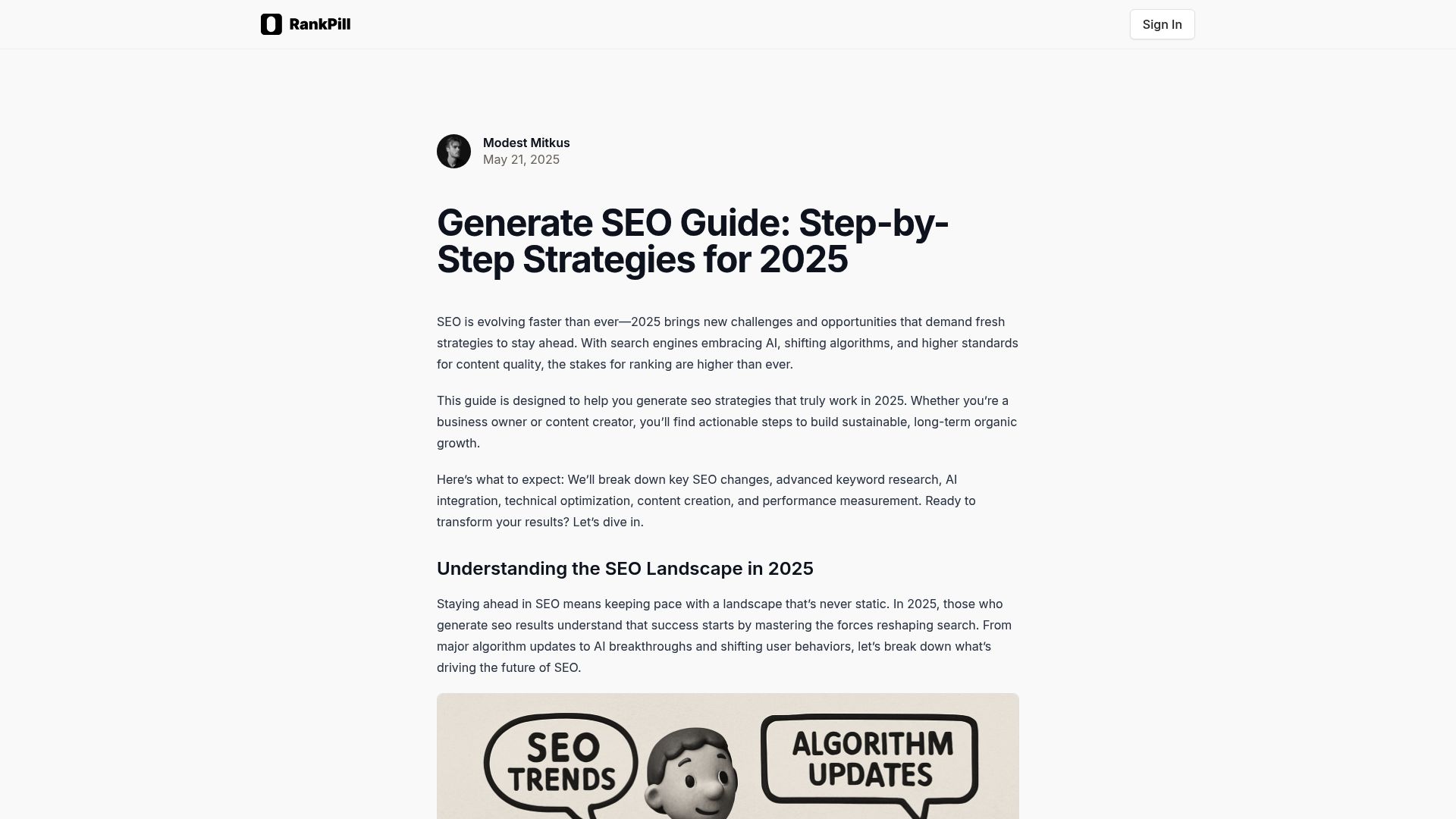Struggling to get your articles noticed on Google? You’re definitely not alone. With over 90% of online experiences starting on a search engine, it’s no wonder so many writers and businesses feel lost when their content never makes it to page one.
The difference between digital obscurity and massive organic traffic often comes down to writing articles for seo. Imagine what it would be like to consistently rank at the top for your target keywords, bringing a steady flow of interested visitors to your site.
This step-by-step guide is designed for beginners. We’ll break down the latest strategies for keyword research, planning, writing, on-page optimization, and avoiding common mistakes—so you can master SEO and drive real results in 2025.
Understanding SEO and Its Importance in 2025
Are you new to writing articles for SEO, or just trying to keep up with the latest changes? You’re not alone. SEO is always evolving, and understanding its core principles is essential if you want your content to rank in 2025. Let’s break down what makes SEO so valuable—and why it’s still the foundation of online visibility.

What is SEO and Why Does It Matter?
SEO, or Search Engine Optimization, is the practice of optimizing your content so it appears higher in search engine results. It’s a key player in digital marketing and content strategy because search engines like Google are the main way people discover new information. In fact, 68% of online experiences begin with a search engine, showing just how vital SEO is for visibility.
When you focus on writing articles for SEO, you’re not just targeting algorithms—you’re building your brand’s authority and making sure your audience finds you first. Search engines rank content based on relevance, quality, and authority. This means well-optimized articles can put your site in front of the right people at the right time.
Key SEO Trends for 2025
Staying ahead in writing articles for SEO means understanding the latest trends. Google’s algorithms are evolving rapidly, especially with the introduction of AI-powered search and SGE (Search Generative Experience). AI-generated content is becoming more common, so writers need to focus on originality and value.
User intent is now a top priority—search engines want to deliver answers that match what people are really looking for. Voice search and mobile-first indexing are also major factors, with more users speaking their queries or searching on mobile devices. Did you know that over half of teens and adults use voice search every day? Adapting your strategy for these trends is critical.
How SEO Articles Drive Traffic and Conversions
High-quality content is at the heart of writing articles for SEO. When your articles are optimized, they rank higher, driving more organic visitors to your website. This increase in traffic can lead to more leads and sales. For example, businesses that blog get 55% more website visitors, highlighting the direct impact of SEO on growth.
A small business, for instance, tripled its website traffic simply by publishing consistent, optimized articles. By focusing on valuable topics and search intent, you can turn casual readers into loyal customers.
Common Myths and Misconceptions
There are many myths about writing articles for SEO. Some believe SEO is just about keywords, or that longer articles always rank better. Others think SEO is a one-time effort, but the reality is much different.
Most users never scroll past the first page of search results, so simply publishing content isn’t enough. According to data, 75% of users never go beyond page one. Success means ongoing optimization, relevant topics, and adapting to search engine updates.
The Beginner’s Mindset: Learning and Adapting
SEO is not static. If you’re just starting with writing articles for SEO, it’s important to embrace a mindset of continuous learning. Search engines frequently update their algorithms, and best practices shift as new trends emerge.
Stay current by following resources like Google Search Central or leading industry blogs. Being open to change and always testing new approaches will help you keep your articles visible and effective in 2025.
Step 1: Keyword Research and Search Intent
Mastering keyword research is the foundation of writing articles for SEO. If you want your content to show up in search results, you need to understand what your audience is searching for and why.
Effective keyword research connects your writing to the real questions and needs of users. By focusing on the right terms, you can ensure your articles get found—and read—by the right people.

Why Keyword Research is the Foundation
Keyword research is at the heart of writing articles for SEO. It’s how you discover the exact words and phrases your audience types into search engines.
When you choose the right keywords, your articles become bridges—connecting what you write to what people actually want to find. For example, targeting “best running shoes 2025” captures users ready to buy, while just “running shoes” is much broader.
Without keyword research, your content could miss the mark, attracting little or no traffic.
Types of Keywords and Their Uses
Understanding the types of keywords is crucial to writing articles for SEO effectively. Keywords fall into two main categories:
| Keyword Type | Example | Purpose |
|---|---|---|
| Short-tail | running shoes | Broad, high search |
| Long-tail | best running shoes 2025 | Specific, lower comp. |
You’ll also encounter:
- Informational keywords (“how to write SEO articles”)
- Navigational keywords (“Nike official site”)
- Transactional keywords (“SEO article writing service”)
Each serves a unique purpose in your content strategy.
Tools and Techniques for Effective Keyword Research
Using the right tools makes writing articles for SEO much more strategic. Free and paid options include Google Keyword Planner, SEMrush, Ahrefs, and Ubersuggest. These tools help you analyze:
- Keyword difficulty
- Search volume
- Trends over time
Competitor analysis also reveals gaps you can target. For rising topics, Google Trends is invaluable. For a deeper dive into keyword and competitor research, check out this Keyword research for SEO articles guide.
Understanding and Satisfying Search Intent
Search intent is the “why” behind every query. When writing articles for SEO, you need to know if users want information, to make a purchase, or to navigate somewhere.
Analyze the SERPs for clues:
- Featured snippets often indicate informational intent.
- Product pages signal transactional intent.
- “How to” queries demand step-by-step guides.
Align your content with the user’s goal to increase relevance and ranking potential.
Mapping Keywords to Content Structure
To organize your writing articles for SEO, group related keywords into topic clusters. Pillar pages cover broad topics, while supporting articles target specific questions.
For example, build a content calendar around a main keyword and several secondary ones. This approach helps you cover a topic comprehensively and signals topical authority to search engines.
Finding Content Gaps and Opportunities
Identifying content gaps is a secret weapon for writing articles for SEO that outperform competitors. Look for underserved topics in your niche using competitor analysis.
If you spot questions your rivals haven’t answered, that’s your chance. An Ahrefs study found 91% of content gets zero organic traffic due to poor targeting—so focusing on gaps can drive real results.
Step 2: Planning and Structuring Your SEO Article
A strong foundation is key when writing articles for seo. Before you type your first word, having a clear plan and structure can make all the difference in how your content performs. Search engines favor well-organized articles, and readers appreciate content that's easy to follow.

The Importance of a Well-Defined Structure
When it comes to writing articles for seo, structure is your secret weapon. A well-defined structure improves readability, keeps users engaged, and helps Google understand your content’s hierarchy.
Articles with clear headings and logical flow are easier for both humans and algorithms to scan. In fact, Backlinko found that well-structured posts with organized headings consistently outrank less organized competitors.
So, before you dive into writing, map out your structure. This sets you up for SEO success.
Crafting Compelling Headlines and Subheadings
Your headline is the first impression—make it count. When writing articles for seo, use attention-grabbing, keyword-rich titles that clearly reflect your topic.
Subheadings (H2, H3) break content into digestible sections. They guide readers and signal topic relevance to search engines. For example, a title like "Writing Articles for SEO: A Complete Guide for Beginners (2025)" targets both readers and the main keyword.
Remember, headlines and subheadings should be descriptive, concise, and strategically include your target keyword.
Creating an Outline Before Writing
Jumping straight into writing articles for seo without an outline can leave your content scattered and unfocused. Outlining helps you plan each section, align content with keyword clusters, and ensure you address user intent.
Try sketching a simple outline:
- Introduction (set the stage)
- Key sections (mapped to keyword groups)
- Conclusion (recap and next steps)
This approach not only speeds up the writing process but also ensures you don’t miss any critical points.
Integrating Visual Elements and Media
Visuals matter more than ever when writing articles for seo. Images, infographics, and videos break up text and make information easier to absorb.
To maximize SEO impact:
- Use high-quality images and original graphics
- Add descriptive alt text with relevant keywords
- Include captions that reinforce your main ideas
MDG Advertising reports that articles with images get 94% more views. Visuals boost engagement and can even help your content rank in image search results.
Internal and External Linking Strategies
Links are the backbone of effective writing articles for seo. Internal links connect your new article to relevant pages on your site, guiding users and spreading link authority.
Meanwhile, citing credible external sources builds trust and adds value. For a deeper dive into successful strategies, check out this SEO content creation guide.
Aim for a balanced mix—link to cornerstone content internally, and reputable sources externally. Use descriptive anchor text that tells both readers and search engines what to expect.
Content Length and Depth: What Works in 2025?
Debates about word count are common in writing articles for seo. Data from Backlinko shows top-ranking articles average around 1,447 words, but depth and relevance matter more than raw length.
Focus on covering your topic comprehensively without fluff. Address all major questions, provide real value, and avoid keyword stuffing. Quality always beats quantity, especially as Google’s algorithms become more sophisticated.
Using AI Tools to Streamline Planning
AI is transforming how we approach writing articles for seo. AI-powered tools can help you research keywords, create detailed outlines, and even suggest headlines.
Automation saves time and reduces the risk of missing important SEO elements. Many platforms now offer user-friendly interfaces that make planning and structuring content easier for beginners and pros alike.
Step 3: Writing SEO-Optimized Content
Writing articles for SEO is both an art and a science. The goal is to create valuable content that’s enjoyable for humans, but also meets the technical needs of search engines. Let’s break down a proven approach that helps your articles climb the rankings in 2025—and keeps your readers engaged from the first word to the last.
Writing for Humans First, Search Engines Second
The foundation of writing articles for SEO is to prioritize your audience. Search engines like Google reward content that genuinely helps users. Avoid writing only for algorithms or stuffing keywords unnaturally.
Focus on clarity and value. Explain concepts simply, answer questions directly, and use examples your readers care about. Google’s Helpful Content Update emphasizes the importance of user-first writing, so always ask: “Does my article solve the reader’s problem?”
Short, conversational sentences work best. Break up ideas into bite-sized blocks to keep your article scannable. Remember, you’re writing for people—search engines just follow their lead.
Crafting Engaging Introductions and Hooks
First impressions matter, especially in writing articles for SEO. Your introduction must grab attention immediately. Try opening with a compelling question, bold statement, or surprising statistic relevant to your topic.
For example, “Did you know that over 90% of online experiences start with a search engine?” instantly draws readers in. Address their pain points, and make it clear what benefit they’ll get from reading further.
A strong hook encourages visitors to stay, reducing bounce rates and signaling to search engines that your content is valuable. End your intro by previewing what’s ahead, setting clear expectations for readers.
Using Keywords Naturally and Effectively
Keywords are the bridge between your content and search queries. When writing articles for SEO, placement and context matter more than sheer repetition.
Here’s how to use keywords effectively:
- Include your main keyword in the title, introduction, at least one subheading, and throughout the body.
- Use variations and synonyms for semantic SEO.
- Keep the flow natural—avoid awkward phrasing just to fit in keywords.
For example, rather than repeating the exact phrase, sprinkle in related terms and questions your audience might ask. If you’re unsure, check out Avoiding keyword stuffing in writing for more on striking the right balance.
Optimizing for Featured Snippets and Zero-Click Searches
Featured snippets are the “position zero” on Google’s results page. To increase your chances of being featured, structure parts of your article to answer questions concisely.
Common snippet formats include:
| Format | Example Use |
|---|---|
| Q&A | What is SEO? |
| Numbered List | Steps to write SEO |
| Table | Comparison of tools |
Use bullet lists, short paragraphs, and direct answers. For “how to” queries, provide step-by-step instructions. Around 19% of SERPs now include a featured snippet, so optimizing for these boosts your visibility.
Enhancing Readability and Engagement
Engagement signals—like time on page and scroll depth—impact how well writing articles for SEO can rank. To keep readers hooked:
- Write in short paragraphs (2–3 sentences).
- Use bullet points and numbered lists for clarity.
- Incorporate real-life examples and storytelling.
Check your Flesch Reading Ease score to ensure accessibility. The easier your content is to read, the more likely visitors are to stick around. Transition words help guide readers smoothly from one idea to the next.
How AI Platforms Like RankPill Simplify SEO Article Writing
AI-powered platforms are transforming writing articles for SEO. Tools like RankPill automate keyword research, generate outlines, optimize content, and even publish articles.

For beginners, this means less time spent on repetitive tasks and more focus on creativity. AI ensures consistency, helps avoid technical mistakes, and boosts your chances of higher rankings. If you’re interested in leveraging these advancements, explore AI tools for article generation for practical guidance.
Incorporating E-E-A-T Principles (Experience, Expertise, Authoritativeness, Trustworthiness)
Google’s E-E-A-T guidelines set the gold standard for quality. Demonstrate real-world experience by sharing personal insights or case studies when writing articles for SEO.
Cite reputable sources to back up your claims. Add an author bio to establish expertise and build trust. These elements signal to both readers and search engines that your content is credible and worth ranking.
Step 4: On-Page SEO Optimization Techniques
Optimizing your content for on-page SEO is a crucial step in writing articles for seo that actually rank. By focusing on technical and structural elements, you help search engines understand your content—and make it more appealing to visitors. Let’s break down the most important techniques for 2025.
Essential On-Page SEO Elements
Mastering the basics is non-negotiable when writing articles for seo. Start with compelling title tags that feature your primary keyword at the beginning. Write concise, enticing meta descriptions that encourage clicks. Structure your URLs to be short, descriptive, and include relevant keywords.
Remember, optimizing these elements can be the difference between ranking on page one or being invisible, especially since 75% of users never scroll past the first page of results. Every detail matters for both visibility and click-through rates.
Optimizing Headings and Content Hierarchy
Headings are the backbone of your article’s structure. Use H1 for your main title and H2s and H3s to break down content into logical sections. This helps both readers and search engines navigate your piece.
When writing articles for seo, naturally include your target keywords in headings, but don’t overdo it. Organized headings signal topical relevance and make your article more scannable, which Google loves. Well-structured articles consistently outrank those with poor hierarchy.
Image and Media Optimization
Visuals can give your content a significant SEO boost. Add relevant images, infographics, or videos to illustrate points and break up text. For every image, write descriptive alt text with keywords where appropriate.
Compress files to ensure fast load times, as slow pages frustrate users and hurt rankings. When writing articles for seo, remember that media elements not only improve user experience but also increase the chances of your content appearing in image search results.
- Use original graphics where possible
- Add captions for context
- Choose file names with descriptive keywords
Internal Linking for SEO Power
Internal links help distribute authority across your site and keep users engaged. When writing articles for seo, link to related blog posts, cornerstone content, or relevant product pages using descriptive anchor text.
This strategy helps search engines understand relationships between pages and boosts the visibility of your most important content. Be intentional—only link where it adds value for the reader, and avoid overloading your article with unnecessary links.
Schema Markup and Rich Snippets
Schema markup is a form of structured data that tells search engines more about your content. Implementing schema can enhance your listings with rich snippets like ratings, FAQs, or how-to steps.
When writing articles for seo, consider these common schema types:
- Article
- FAQ
- HowTo
- Product
Adding schema can increase click-through rates by up to 30%, making your content stand out in the SERPs. Use tools like Google’s Rich Results Test to ensure your schema is working correctly.
Mobile Optimization and Core Web Vitals
With most users searching on mobile, your content must be mobile-friendly. Responsive design, legible fonts, and easy navigation are essential. Google’s Core Web Vitals focus on loading speed, interactivity, and visual stability—key factors in writing articles for seo that perform well.
Here’s a quick summary:
| Metric | What It Measures | Good Value |
|---|---|---|
| LCP | Loading Performance | ≤ 2.5 seconds |
| FID | Interactivity | ≤ 100 ms |
| CLS | Visual Stability | ≤ 0.1 |
Use tools like PageSpeed Insights to test and improve your scores. A seamless mobile experience keeps visitors engaged and signals quality to Google.
Step 5: Editing, Publishing, and Tracking Results
Perfecting your content is just as important as creating it. The final stage in writing articles for seo is where your hard work comes together, ensuring your article is polished, discoverable, and future-proof. Let’s walk through the essential steps for editing, publishing, and tracking your SEO article’s performance.
The Editing and Proofreading Process
Before publishing, take time to carefully review your article. Editing is vital for ensuring clarity, flow, and accuracy—especially when writing articles for seo. Use tools like Grammarly or Hemingway to catch grammar mistakes and improve readability.
- Check for spelling and punctuation errors.
- Ensure your keyword is used naturally.
- Read your article aloud to spot awkward phrasing.
- Ask a peer to review for a fresh perspective.
A clean, error-free article builds trust and keeps readers engaged. Remember, even small mistakes can impact your authority and SEO performance.
SEO Checklist Before Publishing
A thorough SEO checklist guarantees your article is optimized for search engines. When writing articles for seo, double-check the basics before you hit publish:
- Is your primary keyword in the title, meta description, and first paragraph?
- Have you used relevant internal and external links?
- Are your images optimized with descriptive alt text?
- Did you structure your content with clear headings?
Using a pre-publish checklist helps prevent missed opportunities and ensures your article is ready to rank. This step is your final guardrail against costly oversights.
Publishing Best Practices
Timing and visibility matter. When writing articles for seo, schedule your content for when your audience is most active. Submit your URL to Google Search Console to prompt faster indexing.
- Share your new article across social media channels.
- Promote it in your email newsletter.
- Consider republishing on platforms like Medium or LinkedIn for extra reach.
A strategic publishing approach amplifies your article’s impact and increases the chances of early traffic and engagement.
Tracking Performance and Measuring Success
After publishing, monitoring your results is crucial for long-term success. Use Google Analytics and Search Console to track key metrics:
- Impressions and clicks
- Bounce rate and dwell time
- Keyword rankings
Adjust your strategy based on what’s working. Keep an eye on trends, as AI-generated content now accounts for 19.1% of content in Google's top 20 search results. This highlights the need to adapt quickly when writing articles for seo to stay competitive.
Updating and Repurposing Content for Longevity
SEO is not a one-time task—ongoing updates are essential. When writing articles for seo, revisit older posts to refresh information, add new insights, or optimize for emerging keywords.
- Update statistics and examples.
- Repurpose articles into infographics or short videos.
- Merge thin posts into comprehensive guides.
Businesses that regularly update content see significant traffic gains. Keeping your articles current ensures lasting relevance and stronger rankings.
Now that you’ve seen how step-by-step SEO article writing can drive real results—even if you’re just starting out—why not put these strategies into action? With tools like RankPill, you don’t have to feel overwhelmed by keyword research, content planning, or keeping up with Google’s changes. Everything from brainstorming topics to optimizing and publishing can be streamlined, so you can focus on growing your site and reaching more readers. If you’re ready to make your content work harder for you, let’s take the next step together—Get Started.